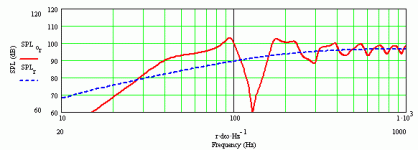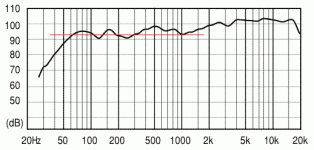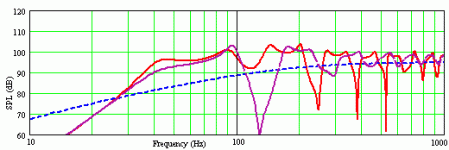Therein lies a question. Top tip: don't take everything you read as gospel.
The 39Hz is the driver Fs, or free air resonance. But that doesn't automaticaly mean it's going to give you that frequency very loudly in every single box you stick it in. For example, if you dropped the driver into a 15 litre sealed box, bass would be a bit of a problem, right? Well, same goes for horns. They need to be big to go low, even if you use quarter-wave loading to boost the bottom end, and shift over to horn loading higher up. Where the 80Hz Wilmslow state comes from is anybody's guess though, because the reglar 206 box will go about an octave lower, as you can see here. You can also see why I prefer the Sigma cabinet over the regular 206 box for more than just aesthetic reasons. The huge dip will be partially filled in by the room's vertical mode, but even so, it's not something I'd tend to favour. The ripple in the Sigma cabinet's response however is higher up, and can be mostly killed by judicious application of damping materials.
MDF? Don't panic -it's not as bad as some say, but it's not ideal by itself. The reason we don't like it for horns is that it has a very unpleasent break-up mode (efectively the point at which energy stored in the panel is released). For FR applications, to avoid this break-up occuring in the enclosure's operational passband, it needs to be at least 1 1/4in thick to push panel resonance below this point. Luckily, most of the panels in these cabinets are lamimated to that thickness or more so you should be reasonably OK.
The 39Hz is the driver Fs, or free air resonance. But that doesn't automaticaly mean it's going to give you that frequency very loudly in every single box you stick it in. For example, if you dropped the driver into a 15 litre sealed box, bass would be a bit of a problem, right? Well, same goes for horns. They need to be big to go low, even if you use quarter-wave loading to boost the bottom end, and shift over to horn loading higher up. Where the 80Hz Wilmslow state comes from is anybody's guess though, because the reglar 206 box will go about an octave lower, as you can see here. You can also see why I prefer the Sigma cabinet over the regular 206 box for more than just aesthetic reasons. The huge dip will be partially filled in by the room's vertical mode, but even so, it's not something I'd tend to favour. The ripple in the Sigma cabinet's response however is higher up, and can be mostly killed by judicious application of damping materials.
MDF? Don't panic -it's not as bad as some say, but it's not ideal by itself. The reason we don't like it for horns is that it has a very unpleasent break-up mode (efectively the point at which energy stored in the panel is released). For FR applications, to avoid this break-up occuring in the enclosure's operational passband, it needs to be at least 1 1/4in thick to push panel resonance below this point. Luckily, most of the panels in these cabinets are lamimated to that thickness or more so you should be reasonably OK.
Attachments
wixy said:What is the reason exactly for not building the cabinet out of mdf?
I'm currently constructing the 208 sigma enclosure for fe206e's out of mdf, so now i'm a bit concerned!
Instead of repeating myself. i'll point you to another current thread where MDF vrs BB is taking place.
http://www.diyaudio.com/forums/showthread.php?postid=1154826#post1154826
Fostex specifies plywood for a reason... over on the FR forum where people have been doing & discussing these & other horns for sometime, i don't know how many times i've see the comment, "next time i'm going to use plywood" or "i'm going to rebuild these with plywood"
Given the effort involved there is plenty of reason to build them out of the right stuff.
dave
emperor said:Its funny that the Fostex driver (alone) on the wilmslow audio website says, that the specs for the 206 are as follows
Frequency range - 40Hz-20kHz !!!
Surely that cant mean that the horn cuts the Bass?, hmmmm
i think this is a mistake on the website for the labyrinth
As scott points out, the box is what allows the driver to reach as far down in the bottom as they can. In a simple sealed box, the 206's bass response runs out of steam in the 200-250 Hz range.
Here is what Fostex claims for the 206 horn FR. Red line is my addition. This chart clearly shows the expected ripple from the small mouth.
dave
Attachments
Hi emperor,
>>Surely that cant mean that the horn cuts the Bass?, hmmmm<<
They don't, not in the real sense of the word - they just stop amplifying. Look at Scott's sim - the range where the horn response (red line) is above the dotted blue line (speaker in free air) is the range where the horn gives you oomph for free.
If the sim still doesn't look very impressing, bear a few things in mind - get yourself something to drink before you read on, barrage of whaffle following.
a) Low cutoff of a horn is determined by size, and we're talking SIZE here. A horn that goes flat down to 20Hz at useable power input is something your neighbours will try to park their cars in.
b) Don't believe sims or measures you aren't able to have cooked yourself. I have a strong suspicion that Scott has set his sights on his simulations to be as pessimistic as the program allows. Real results from the cab will be better. The few sims I could do with a different program whenever health allowed and I had all the data were a lot nicer.
c) As to the early rolloff in bass - no problem at all. The "20Hz to 20KHz" rule is what engineers are told nowadays to measure out of even a tiny bookshelf speaker. It's pure soft brown matter. The PR people "Sir, I have a degree in philosophy, you need me in your tech firm" have read the "Red Book"- not by Maozhedong, but by the people who decided what a CD must be able to do. A CD is digital, so it really chops where it's told to do. nothing below or above 40 to 15...regions where speaker cabs still do a good job just aren't there if the CD doesn't go 20 to 20.
d) Now we go into it. The norms that tell where a speaker still works fine take our hearing into the calculation. German DIN 45500 allows a drop of 8 dB in the highs and, hold tight now, 10 dB in bass for boxes we still agree to. Look at Scott's sim again, and factore in that only very few instruments can deliver bass below 42 Hz - the lowest note a bass, double bass or electric, can do.
e) So, if you want a really big church organ playing in your livingroom, have an architect to redisign your flat to a few thousand squre meters - if you want your favourite music to have you grinning, go for a horn.
Long whaffle, as promised, and little sense if you don't have a look at the little knowledge behind it - speakerbuilding ain't a science, it's "I know little, but I bluidy try"
Greets,
 Pit
Pit
>>Surely that cant mean that the horn cuts the Bass?, hmmmm<<
They don't, not in the real sense of the word - they just stop amplifying. Look at Scott's sim - the range where the horn response (red line) is above the dotted blue line (speaker in free air) is the range where the horn gives you oomph for free.
If the sim still doesn't look very impressing, bear a few things in mind - get yourself something to drink before you read on, barrage of whaffle following.
a) Low cutoff of a horn is determined by size, and we're talking SIZE here. A horn that goes flat down to 20Hz at useable power input is something your neighbours will try to park their cars in.
b) Don't believe sims or measures you aren't able to have cooked yourself. I have a strong suspicion that Scott has set his sights on his simulations to be as pessimistic as the program allows. Real results from the cab will be better. The few sims I could do with a different program whenever health allowed and I had all the data were a lot nicer.
c) As to the early rolloff in bass - no problem at all. The "20Hz to 20KHz" rule is what engineers are told nowadays to measure out of even a tiny bookshelf speaker. It's pure soft brown matter. The PR people "Sir, I have a degree in philosophy, you need me in your tech firm" have read the "Red Book"- not by Maozhedong, but by the people who decided what a CD must be able to do. A CD is digital, so it really chops where it's told to do. nothing below or above 40 to 15...regions where speaker cabs still do a good job just aren't there if the CD doesn't go 20 to 20.
d) Now we go into it. The norms that tell where a speaker still works fine take our hearing into the calculation. German DIN 45500 allows a drop of 8 dB in the highs and, hold tight now, 10 dB in bass for boxes we still agree to. Look at Scott's sim again, and factore in that only very few instruments can deliver bass below 42 Hz - the lowest note a bass, double bass or electric, can do.
e) So, if you want a really big church organ playing in your livingroom, have an architect to redisign your flat to a few thousand squre meters - if you want your favourite music to have you grinning, go for a horn.
Long whaffle, as promised, and little sense if you don't have a look at the little knowledge behind it - speakerbuilding ain't a science, it's "I know little, but I bluidy try"
Greets,
 Pit
PitWrong attachment, Dave. ;-)
Re the sims, they are pessimistic in a way I suppose, just as the Fostex chart is optimistic. FWIW, I always do a horn sim with no damping material assumed, because I'm focusing purely on the cabinet behaviour. The MathCad plots are 1/2 space, so the room will affect the response compared to what you see on the graph. The Fostex plots are all 1/3 octave smoothed, so they tend to make things look a little better than in fact they are. They're hardly alone in that though, so I'm not criticising -every company, or most, tend to apply some form of smoothing to the measurements.
Re the sims, they are pessimistic in a way I suppose, just as the Fostex chart is optimistic. FWIW, I always do a horn sim with no damping material assumed, because I'm focusing purely on the cabinet behaviour. The MathCad plots are 1/2 space, so the room will affect the response compared to what you see on the graph. The Fostex plots are all 1/3 octave smoothed, so they tend to make things look a little better than in fact they are. They're hardly alone in that though, so I'm not criticising -every company, or most, tend to apply some form of smoothing to the measurements.
Thanks for the advice guys re: use of mdf.
Guess this might be a good opportunity to construct the 2nd speaker out of ply and compare it directly with the mdf speaker.
Although, is there anything at all I can do to negate the effect of using mdf?
What if I were to line all the interior walls with barium impregnated vinyl? This is a material that has the sound deadening properties of lead, and is commonly used in car doors. Some high end Australian speaker manufacturers use it to line their speakers.
I guess though that the added thickness of this material (around 8mm) would screw up the internal dimensions of the speaker and hence I shouldn't use it?
Guess this might be a good opportunity to construct the 2nd speaker out of ply and compare it directly with the mdf speaker.
Although, is there anything at all I can do to negate the effect of using mdf?
What if I were to line all the interior walls with barium impregnated vinyl? This is a material that has the sound deadening properties of lead, and is commonly used in car doors. Some high end Australian speaker manufacturers use it to line their speakers.
I guess though that the added thickness of this material (around 8mm) would screw up the internal dimensions of the speaker and hence I shouldn't use it?
Scottmoose said:Wrong attachment, Dave. ;-)
fixed -- thanx.
Useful overlay, that. Cheers Dave.
I'd leave the existing box as is and do a straight comparison. The main problem you'll probably run into is energy storage causing time-smearing compared to a plywood one, as most of the panels are already doubled in some way or another. That doesn't automatically mean it's bad -just not as good as the other.
I'd leave the existing box as is and do a straight comparison. The main problem you'll probably run into is energy storage causing time-smearing compared to a plywood one, as most of the panels are already doubled in some way or another. That doesn't automatically mean it's bad -just not as good as the other.
wixy said:Although, is there anything at all I can do to negate the effect of using mdf?
It can be mitigated somewhat by using some sort of liquid plastic finish ... you'll want to thin it so that it penetrates as far as possible. If you have already built it, it is probably easier (& better) to just start over.
Jonathan Carr suggests laminating with a layer of fiberglass matt (inside & out)
We are doing some experiments with cedar where we are soaking the raw but cut to shape material in a thinned poly. I'd expect if his was done with MDF it would swell u and might well "explode".
dave
Mates, this is a problem as old as speakerbuilding.
The lamented DJ Schulz (ex Visaton someone, allowed to use any tools he could order and lay hands on) ran exhaustive tests, but they were all done with one unstiffened size of material per run. IMHO SWAG, ply resonances are "smeared", allowing the brain to file them in the same drawer as room resonances - MDF has sharp peaks that are above the treshhold. Unless you build in concrete you have to do with the least availible evil - that's life!
I'd hug anyone who finds the better, and affordable, material - but I doubt it will happen in the threescore and ten we are allowed.
still hoping and
Pit
The lamented DJ Schulz (ex Visaton someone, allowed to use any tools he could order and lay hands on) ran exhaustive tests, but they were all done with one unstiffened size of material per run. IMHO SWAG, ply resonances are "smeared", allowing the brain to file them in the same drawer as room resonances - MDF has sharp peaks that are above the treshhold. Unless you build in concrete you have to do with the least availible evil - that's life!
I'd hug anyone who finds the better, and affordable, material - but I doubt it will happen in the threescore and ten we are allowed.
still hoping and

Pit
- Status
- This old topic is closed. If you want to reopen this topic, contact a moderator using the "Report Post" button.
- Home
- Loudspeakers
- Multi-Way
- The benefits of the Horn...........Speaker


